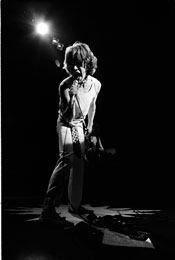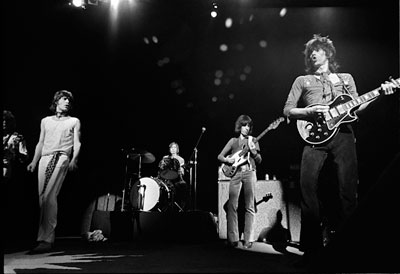
Let It Bleed
by Ethan Russell
Springboard Press

The Rolling Stones tour of America in 1969 was a landmark event that forever changed not only rock music but popular culture – and with it, America. It was the baptism by fire of replacement guitarist Mick Taylor, ushering in what many feel to be the greatest period of, as tour manager Sam Cutler intoned each night, “the greatest rock and roll band in the world.” It spawned the legendary Get Your Ya Ya’s Out live album, which marked a band in transition from the pop tunesters of the Brian Jones era to the riff-driven, blues-heavy improvisations of Taylor and Keith Richards. And when it ended on the dirty hills of the Altamont Motor Speedway, more than Meredith Hunter lay dead.
Photographer Ethan Russell was only in his twenties when he was asked to accompany the tour as the official photographer, joining 15 others who traveled on commercial jets (including the band, amazingly), crossing the United States in the wake of Woodstock, which had occurred only a few months before. When asked at an early press conference why the Stones hadn’t included any free shows on the tour, Mick Jagger (possibly completely spur of the moment) stated the band’s intention to play an “event” in San Francisco, “which has a good scene,” at the end of the tour. The band envisioned it as a “groovy” climax to the tour, a happening in Golden Gate Park, but the planning of it never seemed to occupy much of the Stones’ time or interest as they traversed America, finally playing for crowds who came to listen, not scream.

The Stones had released the Let It Bleed album in November, the first since the death of founder Brian Jones, although the elfish guitarist had ceased to be a truly functional member of the band a while before, leaving Keith Richards to perform the majority of the guitar work both live and in the studio. The addition of Mick Taylor, who, in the words of bassist Bill Wyman, was “much more technically accomplished than the rest of us,” gave Richards a break, allowing him to focus on rhythm playing and letting the gifted Taylor play lead. Together they spoke in a single voice, with the pumping Chuck Berry riffs of Richards laying the foundation for Taylor’s sensuous, melodic lead lines. Listening to Ya Ya’s or various bootlegs from the tour shows a band at its height, with telepathic communication at 150 db. Jagger could still sing then, and it was the beginning of the bands heyday, with Sticky Fingers and the masterpiece Exile on Main Street to come.
Many of Russell’s iconic images from this tour have been imprinted on our collective understanding of what rock and roll looks like, from Jagger’s cape to the blissful abandonment that is Keith, but the picture that speaks perhaps the loudest in this compelling and haunting volume shows the band and hangers-on clustered together in tent for warmth, minutes before making their way to the stage at Altamont. Keith sits in the dirt trying to tune a Martin 12-string; his other guitars lay atop a garbage can in a pile. Jagger in satin smokes a cigarette with a Hell’s Angel peering over his shoulder, and the entire scene looks unplanned and slap-dash, with only the vaguest of hints of the trouble to come. The band looks wary, as well they might; Jagger was punched in the face arriving at the speedway, a site which had been moved to only a few dozen hours before, when permits couldn’t be arranged for more suitable venues. They faced a scene of bedlam, with drunken Hell’s Angels roaming the crowd, a crowd without adequate food, water, and facilities. Earlier, Marty Balin of the Jefferson Airplane had been attacked onstage by the bikers hired to “secure” the concert, and it went downhill from there. It’s all captured by the Maysles brothers in the film Gimme Shelter, but Russell’s still images, such as a pool cue raised over the head of soon to be murdered Hunter, focuses us more intently, trying to divine some reason for the tragedy to follow.

Something changed, both in the Stones, and in us, after Altamont. Although the band went on to create legendary works of art, it also found itself held captive to Richards’ drug use, which nearly broke up the band when he was arrested in Toronto less than a decade later. Taylor departed, shell-shocked and with his own chemical demons to battle only five years after this tour, and the band, while becoming more successful as a brand, lost something indefinable along the way. And what of the America of Woodstock – those happy children drenched in peace and love that were going to change the world? They transformed as well, from purpose-driven hippies to a generation of drug-addled, broken adults who watched the promise and momentum of the Woodstock Nation slip from their fingers, never to be seen again. Hunter Thompson wrote of this in his version of Exile, Fear and Loathing in Las Vegas:
And that, I think, was the handle – that sense of inevitable victory over the forces of Old and Evil. Not in any mean or military sense; we didn’t need that. Our energy would simply prevail. There was no point in fighting – on our side or theirs. We had all the momentum; we were riding the crest of a high and beautiful wave. . . .
So now, less than five years later, you can go up on a steep hill in Las Vegas and look West, and with the right kind of eyes you can almost see the high-water mark – that place where the wave finally broke and rolled back.
That wave broke in those hills outside San Francisco on a cold December day for many people, and Ethan Russell has captured that moment from his unique vantage point, 40 years ago. Let It Bleed: The Rolling Stones, Altamont, and the End of the Sixties is easily one of the finest looks at the Stones to be penned, and one of the best pieces of rock journalism you’ll ever encounter. As Russell states in his introduction, most of the people he documents within the pages of Let It Bleed haven’t spoken much about their experiences since 1969, and the story they tell is both illuminating and haunting. Every page is a revelation of image and storytelling. This book is essential for anyone who wants to understand both the Rolling Stones and the world they changed.
Ethan Russell: http://www.ethanrussell.com












